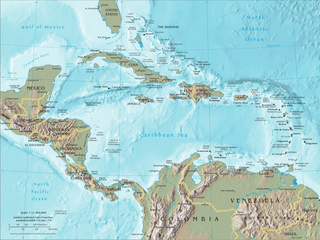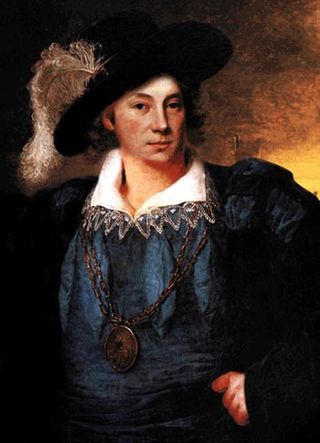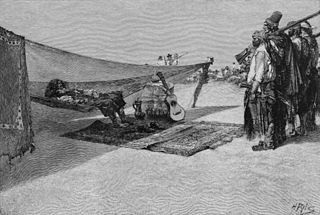Related Research Articles

The era of piracy in the Caribbean began in the 1500s and phased out in the 1830s after the navies of the nations of Western Europe and North America with colonies in the Caribbean began combating pirates. The period during which pirates were most successful was from the 1660s to 1730s. Piracy flourished in the Caribbean because of the existence of pirate seaports such as Port Royal in Jamaica, Tortuga in Haiti, and Nassau in the Bahamas. Piracy in the Caribbean was part of a larger historical phenomenon of piracy, as it existed close to major trade and exploration routes in almost all the five oceans.

Bluefields is the capital of the South Caribbean Autonomous Region in Nicaragua. It was also the capital of the former Kingdom of Mosquitia, and later the Zelaya Department, which was divided into North and South Caribbean Coast Autonomous Regions. It is located on Bluefields Bay at the mouth of the Bluefields River in the municipality of the same name.
William Wright was an English privateer in French service and later buccaneer who raided Spanish towns in the late 17th century.
This timeline of the history of piracy in the 1680s is a chronological list of key events involving pirates between 1680 and 1689.

Vice Admiral Sir Christopher Myngs was an English naval officer and privateer, most notably in the Colony of Jamaica. He came from a Norfolk family and was a relative of Admiral Sir Cloudesley Shovell. Samuel Pepys' story of Myngs' humble birth, in explanation of his popularity, has now been evaluated by historians as being mostly fictitious in nature.
Henry Jennings was an 18th-century English privateer from the colony of Bermuda, who served primarily during the War of the Spanish Succession and later served as leader of the pirate haven or "republic" of New Providence.
Samuel Axe was an English privateer in Dutch service during the early 17th century.
Thomas Paine (1632–1715) was a colonial American privateer who, during the late 17th century, raided several Spanish settlements. He participated in a raid with Jan Willems, looting Rio de la Hacha in 1680 as well as driving the French out of Block Island. In June of the same year, Paine joined forces with Michel de Grammont and a captain named Wright at Blanquilla Island. Together with 50 men they successfully raided the town of Cumana although it was defended by 2,000 Spanish soldiers.

Laurens Cornelis Boudewijn de Graaf was a Dutch pirate, mercenary, and naval officer in the service of the French colony of Saint-Domingue during the late 17th and early 18th century.
John Morris was an English buccaneer active in the Caribbean during the 1660s and early-1670s. His son, John Morris the Younger, held a command of his own ship during his father's later expeditions against Portobelo and Maracaibo. John Morris the Younger was one of the commanders killed in an explosion during a party on board Henry Morgan's flagship in 1670.
This timeline of the history of piracy in the 1640s is a chronological list of key events involving pirates between 1640 and 1649.
The history of the Jews in Jamaica predominantly dates back to migrants from Spain and Portugal. Starting in 1509, many Jews began fleeing from Spain because of the persecution of the Holy Inquisition. When the English captured Jamaica from Spain in 1655, the Jews who were living as conversos began to practice Judaism openly. By 1611, the Island of Jamaica had reached an estimated population of 1,500 people. An estimated 75 of those people were described as "foreigners," which may have included some Portuguese Jews. Still, many Jews faced persecution from English merchants.
Laurens Prins, anglicized as Lawrence Prince, was a 17th-century Dutch buccaneer, privateer and an officer under Captain Sir Henry Morgan. He and Major John Morris led one of the columns that raided Panama in 1671.
Jan Willems, also known as Janke or Yankey Willems, was a 17th-century Dutch buccaneer. Based out of Petit-Goâve, Willems participated in a number of expeditions against the Spanish during the early to mid-1680s with other well-known privateers including Michiel Andrieszoon, Thomas Paine, Laurens de Graaf, Nicholas van Hoorn and Michel de Grammont.
Bluefields is a settlement in Westmoreland Parish on the Caribbean island of Jamaica. It contains a major beach, Bluefields Beach.
Jewish pirates were seafaring Jewish people who engaged in piracy. While there is some mention of the phenomenon in antiquity, especially during the Hasmonean period, most Jewish pirates were Sephardim who operated in the years following the Alhambra Decree ordering the expulsion of Iberia's Jews. Upon fleeing Spain and Portugal, some of these Jews became pirates and turned to attacking the Catholic Empire's shipping as both Barbary corsairs from their refuge in the Ottoman dominions, as well as privateers bearing letters of marque from Spanish rivals such as the United Netherlands.
The western Caribbean zone is a region consisting of the Caribbean coasts of Central America and Colombia, from the Yucatán Peninsula in southern Mexico to the Caribbean region in northern Colombia, and the islands west of Jamaica are also included. The zone emerged in the late sixteenth century as the Spanish failed to completely conquer many sections of the coast, and northern European powers supported opposition to Spain, sometimes through alliances with local powers.

Between 1665 and 1857, Caribbean pirates and filibusters operated in Lake Nicaragua and the surrounding shores. The Spanish city of Granada, located on the lake, was an important trading centre for much of its early history so it was a prime target for pirates such as Welshman Henry Morgan and freebooters like William Walker.
Jean Fantin was a French pirate active in the Caribbean and off the coast of Africa. He is best known for having his ship stolen by William Kidd and Robert Culliford.

References
- ↑ "The beginning of Bluefields". The Gleaner. September 24, 2010. Retrieved February 20, 2022.
- ↑ "Terebelo Distillery Blauvelt New York Bourbon". www.academia.edu. Retrieved 2022-02-20.
- ↑ "Once upon a time, Jewish pirates ruled the seas". 3 February 2021.